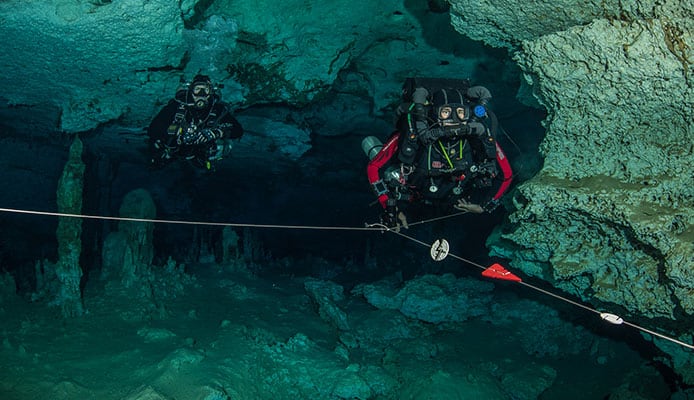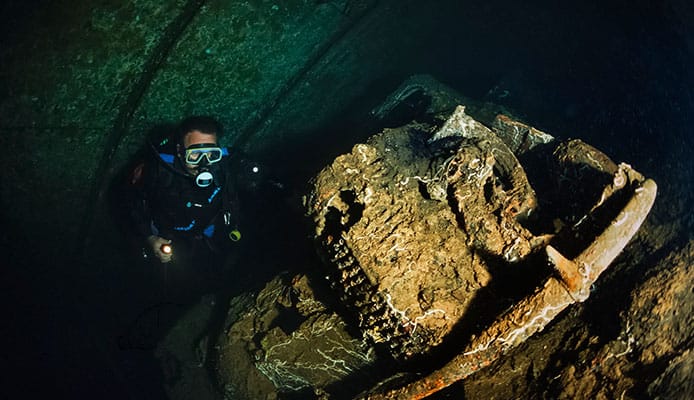
Once you try rebreather diving for the first time you will no longer feel like a noisy spectator or an intruder. You will experience sea life around you in its natural state and feel like you are a part of it. A rebreather will allow you to take your time and explore the sea depths the way you always wanted.
The main reason people switch from heavy dual tanks to rebreathers is quietness and simplicity. This allows you to even swim with smaller fish without them being scared away by the noise. But, how do rebreathers work? Keep reading to find out more!
Rebreather diving – How does it work?
If you’re using an open circuit tank while diving you probably notice that you lose a bulk of gas quite fast. It just bubbles away every time you breathe. Once you start going deeper into the water you will notice that this waste increases dramatically. On the other hand, using a closed-circuit rebreather will lower, or eliminate, wasted exhaled gas. It stays retained within the system, gets filtered, recycled, refreshed, and you can use it again. You will lose bubbles of gas only when you clear your mask or during ascent.
Rebreather diving means that you will have small nitrox blending machine with you all the time. It will keep producing gas for you, no matter the depth you’re at. If you’re asking how do rebreathers work – very simple, they use the Constant PO2 mechanism.
When you’re using an open-circuit scuba tank the Oxygen in the gas mix will stay constant in all depths. Besides, Oxygen’s partial pressure will vary depending on the depth you’re at. On the other hand, rebreathers work oppositely. The partial pressure is held constant thanks to the controller in the rebreather. Also, the amount of oxygen you get from it will vary depending on your depth in the water.
Constant PO2 levels are maintained thanks to the controller a rebreather has built-in. You can set the levels the way you want them to be manually, but about 1.3bar for the rest and 0.7 for descent and surface is ideal. Whenever the pressure of O2 falls below the setpoint, the mechanism will automatically add a fresh squirt of oxygen to regulate it. This results in various O2 percentage.
You may be wondering why oxygen-rich gas is important, but also the best. Well, the answer to this question is fairly simple too. Levels of inert gases such as helium and nitrogen are lowered if there’s a high concentration of oxygen in the gas mix. This means you won’t absorb inert gases as much and create deco obligations. In other words, oxygen-rich equals less deco, greater depth, and more diving time.
Another good question is about the toxicity of Oxygen. The answer is in PO2. Breathing 100% Oxygen is safe if you’re at about 20 feet or the surface. Matter of fact, this is how rebreather diving was done in the past when rebreathers were pure O2 focused. So, imagine you’re using this kit – your O2 partial pressure will be at 1 bar at the surface with a FO2 of 100%. This results in safe PO2. Keep in mind that the safety index for human beings when it comes to oxygen pressure is between 0.16 and 1.6 bar.
You might also like: 5 Best Cold Water Regulators In 2022
Anyways, you will have to pass training before you’re allowed to use a rebreather on your own. This is where you will learn about the importance of PO2 levels. On the other hand, if you tried scuba diving before, you probably heard that keeping your eyes on the amount of gas you have left is the most important thing. With a closed-circuit rebreather, the rule is a bit different – you need to pay attention to the PO2 levels.
FAQ

Q: How long can you dive on a rebreather?
The time you spend diving with a rebreather will vary depending on the cylinders you have. But, the average time you can spend underwater using a rebreather is about 2-3 hours. Rebreathers have either one larger or two smaller cylinders and their volume will vary accordingly.
Q: Why are rebreathers dangerous?
A rebreather will only be dangerous if it starts malfunctioning. Some of the most common problems are a gas mixture supply that has too much or too little Oxygen in it. Too much oxygen and it will cause convulsions, and too little oxygen means you will be at danger to suffocate.
Q: How does a rebreather work in diving?
Diving with a rebreather means you will have a device that filters, cleans, and recycles the air you exhaled for you to use it again. There is one thing a rebreather needs to do to allow you to do that – remove the carbon dioxide you exhaled. Sodium hydroxide canister built-in a rebreather does this for you.
Q: How deep can a Navy SEAL dive with a rebreather?
Dive duration and depth will completely be affected by oxygen consumtion rate and water temperature. But, about 70 feet is as deep as Navy SEALS can go with rebreathers. The rebreather units they use are smaller than open-circuit scuba systems so they use them only in shallow water operations.
Globo Surf Overview
Diving with a rebreather is probably a better way than using a scuba tank if you want to experience sea life in shallow depths. These devices allow you to keep breathing the same air by recycling and filtering the carbon dioxide that you exhale. You can use it for about 2-3 hours before having to get out of the water.
Hopefully, this article helped you to better understand how do rebreathers work. Make sure you go through the necessary training before you decide to use the device on your own. You will learn how to control the PO2 levels at the training and some basic driving techniques. Put on your mask and enjoy the water!

